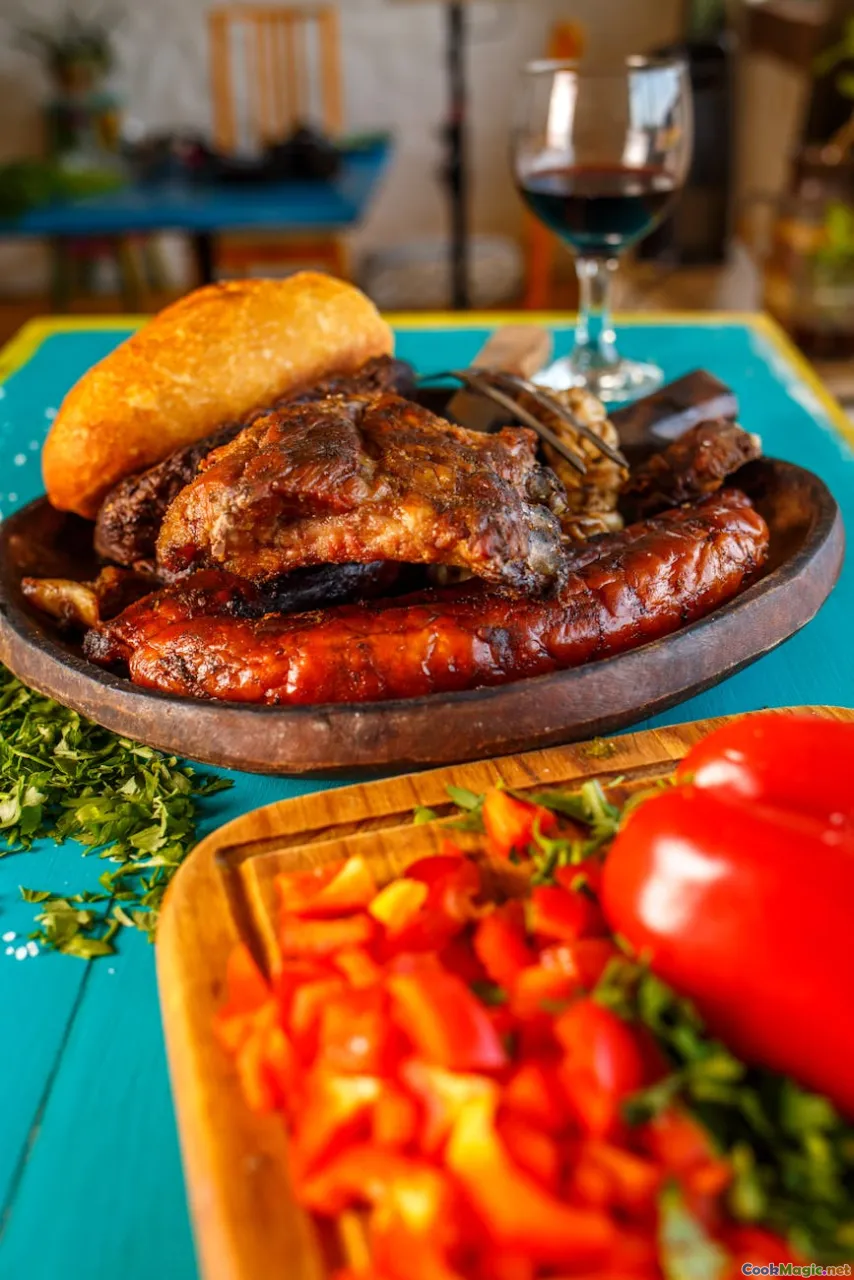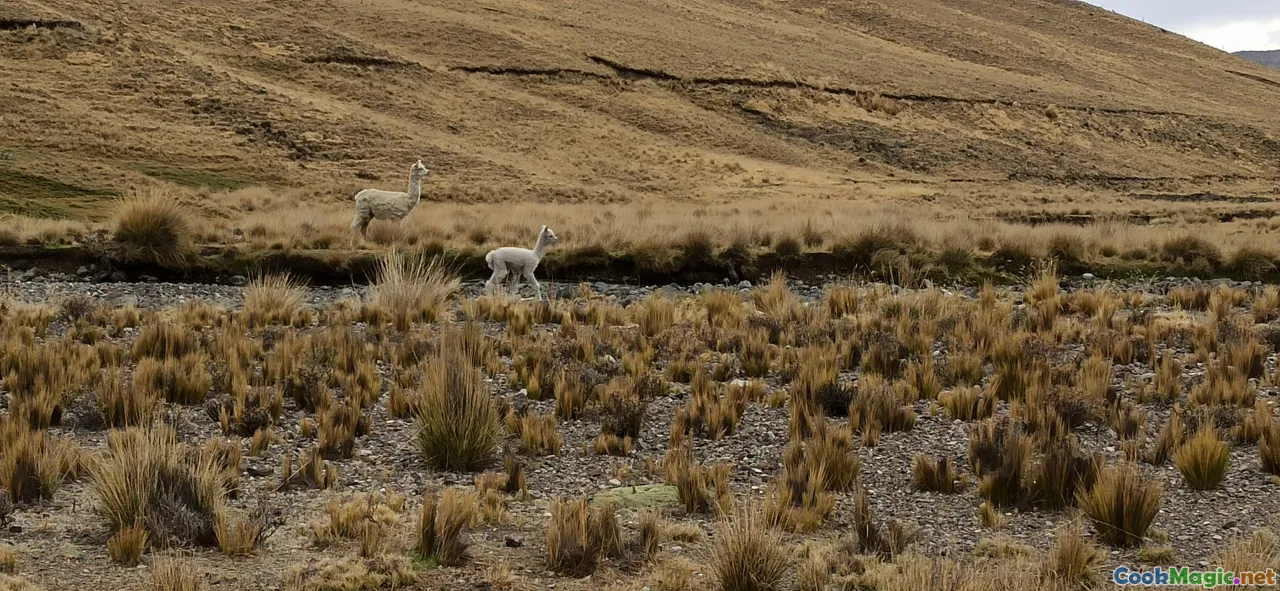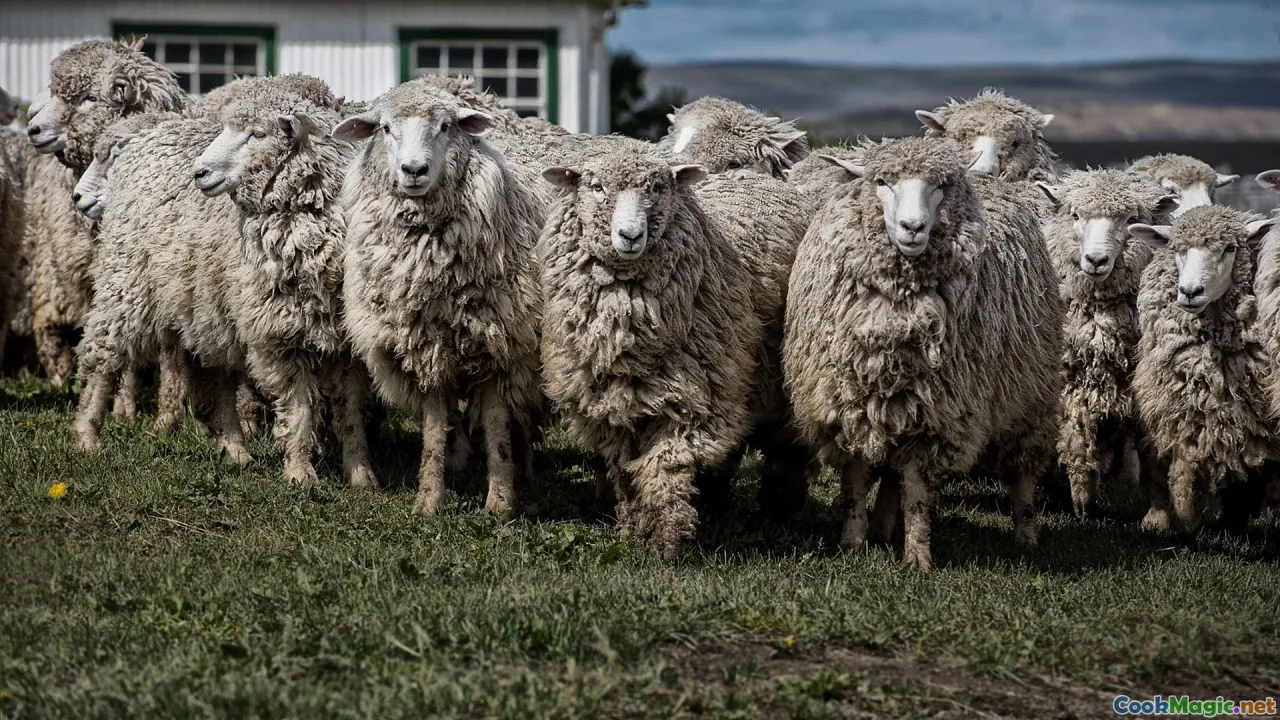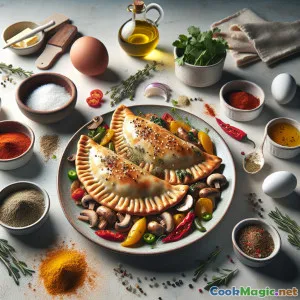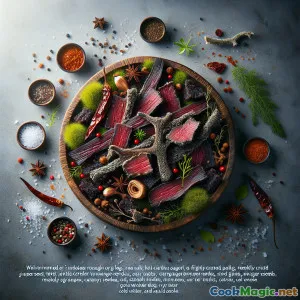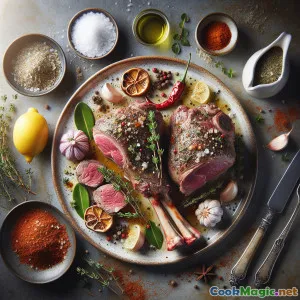
Agneau patagonien rôti dans les braises avec chimichurri d'herbes sauvages
(Ash-Roasted Patagonian Lamb with Wild Herb Chimichurri)
(0 Avis)0
178
octobre 11, 2025
Signaler un problème
Ingrédients
-
3 kg Épaule et gigot d'agneau, avec os (ouvert en papillon)
(Ask butcher to butterfly for even roasting)
-
25 grams Sel de mer gros
(Ajuster au goût)
-
2 tsp Poivre noir fraîchement moulu
(For seasoning the lamb)
-
8 cloves Ail
(Haché finement)
-
2 tbsp Thym Frais
(Chopped; wild thyme if available)
-
2 tbsp Origan séché
(Patagonian-style, robust aroma)
-
2 tsp Paprika fumé
(Adds deep smokiness)
-
1 tsp Piment rouge concassé (piment rouge moulu)
(Ajustez la chaleur selon votre préférence)
-
3 leaves Feuilles de laurier
(Crumbled into the rub)
-
1 tbsp Zeste de citron
(From 1 lemon)
-
2 tbsp Jus de citron
(Pressé à la minute)
-
80 ml huile d'olive (pour marinade)
(Helps carry flavors)
-
30 ml Vinaigre de vin rouge (pour marinade)
(Balances richness)
-
120 ml Eau
(For salmuera basting brine)
-
5 grams Sel gros pour saumure
(Dissolve in warm water)
-
6 kg Bûches de bois dur ou charbon de bois en morceaux
(For embers; use dry hardwood like oak, ñire, or lenga)
-
800 grams Pommes de terre nouvelles (petites)
(Washed, skin-on; for cooking in ashes)
-
30 grams Persil frais
(Finely chopped for chimichurri)
-
1 tbsp Origan frais
(Chopped; or extra dried oregano)
-
1 small Échalote
(Haché finement)
-
0.5 tsp Flocons de piment rouge
(For chimichurri heat)
-
120 ml Huile d'olive (pour chimichurri)
(Extra-virgin)
-
45 ml Vinaigre de vin rouge (pour chimichurri)
(Bright acidity)
-
to taste pinch Sel marin en flocons
(pour la finition)
-
to taste pinch Poivre noir (pour finition)
(Fraîchement moulu)
(Ask butcher to butterfly for even roasting)
(Ajuster au goût)
(For seasoning the lamb)
(Haché finement)
(Chopped; wild thyme if available)
(Patagonian-style, robust aroma)
(Adds deep smokiness)
(Ajustez la chaleur selon votre préférence)
(Crumbled into the rub)
(From 1 lemon)
(Pressé à la minute)
(Helps carry flavors)
(Balances richness)
(For salmuera basting brine)
(Dissolve in warm water)
(For embers; use dry hardwood like oak, ñire, or lenga)
(Washed, skin-on; for cooking in ashes)
(Finely chopped for chimichurri)
(Chopped; or extra dried oregano)
(Haché finement)
(For chimichurri heat)
(Extra-virgin)
(Bright acidity)
(pour la finition)
(Fraîchement moulu)
Nutrition
- Portions: 6
- Taille de portion: 1 assiette (300g)
- Calories: 680 kcal
- Carbohydrates: 0 g
- Protein: 52 g
- Fat: 48 g
- Fiber: 1 g
- Sugar: 1 g
- Sodium: 850 mg
- Cholesterol: 190 mg
- Calcium: 60 mg
- Iron: 5.5 mg
Instructions
-
1 - Build and settle the fire:
Light a hardwood fire or large charcoal bed in a fire pit or kettle grill. Let it burn down until you have a deep bed of glowing embers with only gentle flames.
-
2 - Make the herb paste:
In a bowl, combine minced garlic, thyme, dried oregano, smoked paprika, ají molido, crumbled bay leaves, lemon zest, lemon juice, olive oil (marinade), and red wine vinegar. Stir to a fragrant paste.
-
3 - Season and marinate the lamb:
Pat lamb dry. Sprinkle with coarse sea salt and black pepper. Rub all over with the herb paste, getting into seams and around bones. Rest at room temperature while the embers mature.
-
4 - Prepare salmuera (optional):
Dissolve the coarse salt in warm water to make a light brine. Use this to baste the lamb during roasting to keep it succulent and well-seasoned.
-
5 - Prepare potatoes for the ashes:
If using, pierce new potatoes a few times. Roll lightly in a film of olive oil and a pinch of salt. Set aside near the fire to start warming.
-
6 - Shape the rescoldo bed:
Rake embers into a level bed. For thicker lamb sections, mound extra embers around the sides. Keep additional logs burning nearby to replenish heat as needed.
-
7 - Begin ash-roasting:
Set the lamb on a low trivet or sturdy grate just above the embers, bone-side down. Nestle embers close to the thicker leg and shoulder. Keep flames low—embers do the work.
-
8 - Slow-roast and baste:
Roast gently, maintaining a low, steady heat. Baste with salmuera or herb paste drippings every 20–30 minutes. Add embers as needed to keep a consistent glow without scorching.
-
9 - Roast potatoes in the ashes:
Bury new potatoes at the edge of the embers where heat is moderate. Turn once or twice. They’re done when a skewer slides through easily and skins are char-kissed.
-
10 - Crisp and finish:
In the final stage, move the lamb a touch closer to embers, skin-side down if present, to crisp. Aim for internal temperature 63–70°C, depending on desired doneness.
-
11 - Make the chimichurri:
Combine parsley, fresh oregano, shallot, red chili flakes, olive oil (chimichurri), and red wine vinegar. Season with a pinch of salt and pepper. Let stand 10 minutes to bloom.
-
12 - Rest, Carve, and Serve:
Transfer lamb to a board and rest 15 minutes. Carve along the seams into thick slices. Crack open the ash-baked potatoes. Finish with flaky salt and spoon over chimichurri.
Light a hardwood fire or large charcoal bed in a fire pit or kettle grill. Let it burn down until you have a deep bed of glowing embers with only gentle flames.
In a bowl, combine minced garlic, thyme, dried oregano, smoked paprika, ají molido, crumbled bay leaves, lemon zest, lemon juice, olive oil (marinade), and red wine vinegar. Stir to a fragrant paste.
Pat lamb dry. Sprinkle with coarse sea salt and black pepper. Rub all over with the herb paste, getting into seams and around bones. Rest at room temperature while the embers mature.
Dissolve the coarse salt in warm water to make a light brine. Use this to baste the lamb during roasting to keep it succulent and well-seasoned.
If using, pierce new potatoes a few times. Roll lightly in a film of olive oil and a pinch of salt. Set aside near the fire to start warming.
Rake embers into a level bed. For thicker lamb sections, mound extra embers around the sides. Keep additional logs burning nearby to replenish heat as needed.
Set the lamb on a low trivet or sturdy grate just above the embers, bone-side down. Nestle embers close to the thicker leg and shoulder. Keep flames low—embers do the work.
Roast gently, maintaining a low, steady heat. Baste with salmuera or herb paste drippings every 20–30 minutes. Add embers as needed to keep a consistent glow without scorching.
Bury new potatoes at the edge of the embers where heat is moderate. Turn once or twice. They’re done when a skewer slides through easily and skins are char-kissed.
In the final stage, move the lamb a touch closer to embers, skin-side down if present, to crisp. Aim for internal temperature 63–70°C, depending on desired doneness.
Combine parsley, fresh oregano, shallot, red chili flakes, olive oil (chimichurri), and red wine vinegar. Season with a pinch of salt and pepper. Let stand 10 minutes to bloom.
Transfer lamb to a board and rest 15 minutes. Carve along the seams into thick slices. Crack open the ash-baked potatoes. Finish with flaky salt and spoon over chimichurri.
En savoir plus sur: Agneau patagonien rôti dans les braises avec chimichurri d'herbes sauvages
What makes Cordero Patagónico al Rescoldo special
Cordero Patagónico al Rescoldo celebrates Patagonia’s vast landscapes and minimalist gaucho cooking. Rescoldo is the art of cooking with embers and ash rather than dancing flames—an elemental, patient method that rewards you with unbelievably tender meat, haunting smoke aromas, and a subtle minerality from the ashes. In southern Argentina, lamb is king, and this approach—closely related to asado—a la cruz (cross-frame roasting)—is about coaxing perfection from simple ingredients with time, attention, and firecraft.
This recipe adapts the tradition for home fire pits and kettle grills, relying on a mature bed of embers that radiates even heat. The lamb is seasoned with a robust Patagonian profile: garlic, thyme, oregano, smoked paprika, and a pinch of ají molido for warmth. A light salmuera (salt-water brine) keeps the surface moist and seasoned during the long roast, much like a gentle ocean breeze. Finished with a herb-bright chimichurri and ash-roasted potatoes, the result is a feast that feels both rugged and refined.
Technique notes and fire management
- Embers, not flames: Let hardwood logs (ñire, lenga, or oak) burn down until they glow deep red with only lazy, occasional flames. Flames char too aggressively; embers roast evenly.
- Heat control: Think low and steady. If your hand can hover 15 cm above the embers for 5–6 seconds, you’re in the right zone. Add embers gradually rather than piling on fresh logs.
- Positioning: Place thicker cuts close to the hottest embers and thinner areas a little farther away. If one section races ahead, rake some embers aside or shield with a thin metal sheet.
- Basting: A light salmuera brushed on every 20–30 minutes enhances seasoning and moisture. It also helps herbs adhere and bloom aromatically.
- Doneness: For juicy, blush meat, aim for 63°C (medium). For a more traditional, shreddy texture in shoulder areas, 68–70°C works well. Always rest the lamb before carving.
Flavor architecture
- The rub: Garlic, thyme, and oregano mimic the wild herbs of Patagonia’s windswept steppe. Smoked paprika reinforces the ember character, while lemon brightens the richness.
- The finish: Chimichurri adds herbal zing, gentle heat, and acidity to cut through the luscious lamb fat. It should be vivid, never muddy—let it sit 10 minutes to bloom.
- The sides: New potatoes “al rescoldo” become smoky-sweet with delicate ash-kissed skins and fluffy interiors. Crack them open and drizzle with chimichurri or a knob of butter.
History and cultural significance
Patagonia’s cooking traditions stem from gaucho ingenuity and Mapuche wisdom about land and fire. With scarce equipment and abundant wind, cooking with embers made sense: wood burns down quickly, and embers hold steady heat even when wind whips across the plains. Cordero Patagónico is a signature regional dish—served at family gatherings, festivals, and roadside parrillas—where time slows, conversation grows, and the fire becomes the centerpiece. The ritual of tending embers, basting with salmuera, and rotating the meat has as much to do with community as cuisine.
Substitutions and adaptations
- Cuts: If a whole butterflied lamb isn’t practical, use a combination of bone-in shoulder and leg. Even smaller, a 2–2.5 kg shoulder yields excellent results.
- Herbs: Swap thyme for wild thyme or use a mix of thyme and rosemary. Dried oregano can be replaced with fresh oregano at 3:1 ratio.
- Urban method: On a kettle grill, bank coals to one side for a deep ember bed. Set the lamb low, with vents partially closed to tame airflow. In a pinch, roast at 150–160°C in the oven until nearly done, then finish over a charcoal bed for smoke and char.
- Heat source: Lump charcoal offers clean heat and a neutral smoke profile if hardwood logs aren’t available.
Tips for success
- Dry the lamb thoroughly before seasoning so the rub adheres.
- Keep a dedicated ember feeder fire going nearby. Move only mature embers to the cooking zone.
- Taste your salmuera—salty but not briny. It should season, not cure.
- Protect thin edges: If necessary, tent delicate areas with foil during the slow phase, then remove it to crisp.
- Carving: Follow natural seams—separate leg, shoulder, and ribs, then slice across the grain for tenderness.
Serving and pairing
Serve the lamb piled high on a warmed platter with bowls of chimichurri and a shower of flaky salt. Split the ash-baked potatoes and let diners spoon sauce into the steamy centers. Pair with Patagonian Pinot Noir, a cool-climate Malbec, or a malty amber beer—the acidity or gentle bitterness will freshen each bite.
Why you’ll love it
Cordero Patagónico al Rescoldo captures the soul of Argentinian fire cooking: humble ingredients, patient technique, and flavors that can’t be faked. The gently smoky crust, succulent interior, and bright herbal counterpoint make this dish unforgettable—worthy of a long afternoon and good company around a glowing fire.

